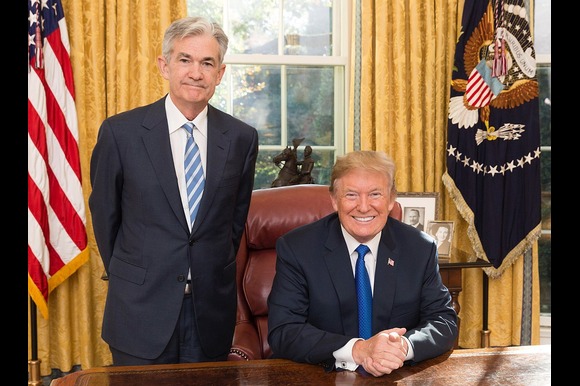U.S. President Donald Trump, who has long criticized Federal Reserve Chairman Jerome Powell, brought his feud into full public view on Thursday during a tense, on-camera exchange over the cost of renovations at the Fed’s headquarters.
Trump, who has spent months lambasting Powell on social media and in press remarks—calling him names such as “numbskull”—visited the Federal Reserve in person, marking the first such visit by a sitting president in nearly 20 years. The visit came as Trump ramps up pressure on Powell to accelerate interest rate cuts, ahead of the Fed’s policy meeting in Washington next week, where rates are widely expected to remain unchanged.
During a tour of the facility, Trump questioned the reported cost of the Fed’s $2.7 billion renovation, suggesting it had ballooned to $3.1 billion. Powell pushed back, shaking his head and saying, “I’m not aware of that,” and that no one at the Fed had provided such a figure. Trump then pulled out a document from his jacket, which Powell briefly reviewed before dismissively handing it back, stating Trump was “adding a third building” to the total.
Trump insisted the structure was a new addition, but Powell countered, saying, “It’s a building that was built five years ago… it’s not new.”
The renovation project, first approved in 2017, includes updates to the historic Eccles Building and a neighboring 1951 structure. According to the Fed’s 2025 budget, the estimated costs have risen from $1.88 billion in 2019 to $2.45 billion, but those increases have been offset by reductions in other renovation budgets. The project is designed to consolidate the bank’s operations across two buildings from the 1930s.
Asked how he would handle such overruns as a real estate developer, Trump told reporters, “Generally speaking, I’d fire him.”
Despite floating the idea of firing Powell on multiple occasions, Trump has consistently walked back those comments. Removing a Fed governor under U.S. law requires proof of misconduct or “cause,” a standard legal experts say cost overruns would not meet. The law is specifically designed to shield the central bank from political influence and ensure economic policy decisions are made independently.
After the visit, Trump wrote on social media that construction “has got a long way to go” and said it “would have been much better if it were never started.” He acknowledged that “cost overruns are substantial,” but insisted the U.S. can “afford just about anything.” He added, “Let’s just get it finished and, even more importantly, LOWER INTEREST RATES!”
Trump maintains that interest rates should be reduced to ease the government’s borrowing costs and help Americans access cheaper loans and mortgages. He has downplayed inflation—measured at 2.7% in June—and claimed it is no longer a serious concern.
Economists have pointed out that Trump’s aggressive economic policies, including tax cuts, higher tariffs, reduced government spending, and immigration crackdowns, have created conflicting pressures on the economy. These dynamics have made it more difficult for the Fed to determine the appropriate course of action. Typically, the central bank lowers interest rates to stimulate a sluggish economy or raises them to combat inflation.
Powell, who was first appointed by Trump in 2017 and later renominated by President Joe Biden, has stated that the economy is currently stable enough to justify a wait-and-see approach to interest rate changes. His term as chairman ends in May 2026.
During Thursday’s exchange, when asked if Powell could say anything that might get Trump to ease his criticism, the president replied that he would “love to lower interest rates.”
Democrats have accused Trump of using the renovation issue as a distraction, particularly as he faces increasing scrutiny over his handling of the Jeffrey Epstein files. They argue he is attempting to position Powell as a scapegoat in case of future economic downturns.
Meanwhile, the Fed has defended the renovation project, attributing cost increases to factors like unexpected asbestos discoveries. It also rejected White House characterizations of luxury features, such as claims the project includes a “VIP elevator.”
Trump’s attacks on Powell have intensified over time, with the president labeling him a “stubborn mule” and “Trump hater.” Yet despite the friction, Powell remains at the helm of the U.S. central bank—for now.






